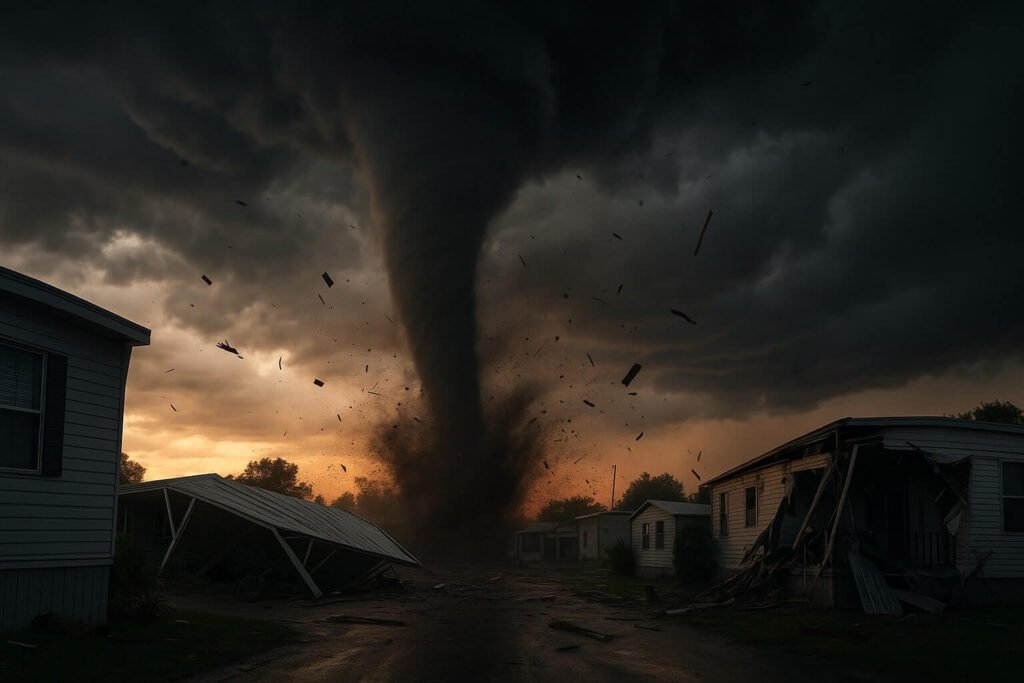On the evening of June 25, 2025, the skies over Largo FL were deceptively calm. The kind of summer dusk where the air hangs thick with humidity, cicadas buzz lazily in the background, and most folks in Pinellas County are winding down with air-conditioning and TV reruns. But by 7 PM, that quiet routine was shattered as a surprise EF-1 tornado carved its way through mobile-home communities southeast of the city center. In just eight minutes, Largo FL experienced its most damaging tornado in over a decade, flipping homes, downing power lines, and shaking an entire community to its core.
What happened in Largo was not the kind of dramatic supercell tornado you’d expect from the Midwest. This was a subtler, sneakier type—what meteorologists call a “landspout”—a tornado that forms near the ground where air boundaries meet, often without the signature radar hook echo that warns storm spotters ahead of time. That’s part of what made this one so dangerous: it formed fast, near the surface, and gave meteorologists only a couple of minutes to issue a warning.
It all began when two boundaries collided—one from a thunderstorm west of St. Pete, the other drifting out of inland Pinellas. Add in a low-pressure pocket aloft and Florida’s ever-persistent muggy atmosphere, and you’ve got the perfect recipe for rotation. The first visible signs were caught on local Doppler around 6:57 PM near Bryan Dairy Road. By 7:02 PM, a thin, twisting funnel dropped down near the Bay Ranch Mobile Home Park.
By the time it dissipated at 7:10 PM, it had tracked just over 2 miles, with peak winds reaching 90 mph. Not catastrophic by tornado standards, but in a vulnerable place like a mobile-home park, that’s enough to do real damage. One manufactured home was completely flipped. Dozens more had roofs peeled off, walls caved in, or carports bent like soda cans. Over 40 homes were damaged in Ranchero Village alone, with another dozen hit in Bay Ranch. Aluminum siding, broken tree limbs, even someone’s laundry basket—all of it ended up scattered across streets and rooftops.
But here’s the miracle: Largo FL saw no serious injuries, no deaths. In a community where many homes were built before modern wind codes, that’s not just luck. That’s the result of quick thinking, alert neighbors, and first responders who were on the scene minutes after the storm passed. Largo Fire Rescue swept through the worst-hit areas, turning off gas lines, checking for trapped residents, and keeping the chaos from escalating.
Within hours, locals started showing up to help. Volunteers brought tarps and bottled water. Churches opened their fellowship halls for displaced families. Utility crews worked overnight to restore power to more than 3,000 homes. Even national response teams like Team Rubicon arrived to help with the mess of twisted metal and downed trees.
This tornado wasn’t a fluke either. While we think of Largo FL and Pinellas County as more hurricane-prone than tornado-prone, the area has a long history of these fast-spinning storms, especially during summer months when sea breezes from both coasts collide over central Florida. Since 1950, at least nine tornadoes have touched down within a 15-mile radius of Largo. Most are EF-0s and EF-1s, but the risk is still very real, particularly for mobile home residents.
The problem? These landspout tornadoes form too low for many radar systems to catch in time. In this case, the warning time was incredibly short—maybe 3 to 5 minutes max. That means relying solely on outdoor sirens or TV alerts isn’t enough. Having a NOAA weather radio in your home or getting wireless emergency alerts on your phone is what can make the difference. When seconds count, hearing that buzz or tone even a minute earlier can give you just enough time to duck into a safer structure.
Another hard truth this storm exposed is the fragility of older mobile homes. Many of the damaged units were built before the 1994 HUD code upgrade, which mandated stronger tie-downs, wind-rated anchoring, and structural improvements. Retrofitting older homes with modern anchors and hurricane straps can cost around $800–$1,200—a lot cheaper than having to rebuild from scratch after a tornado rips your home apart. It’s not a glamorous upgrade, but it’s one that could save your life.
So what can the people of Largo FL learn from this storm? First, that even a short-lived tornado can leave a long-lasting impact. Second, that community response matters. And third, that being prepared isn’t just for Category 4 hurricanes or big-budget disasters. Sometimes the storm that does the most damage is the one you barely see coming.
If you live in Largo FL or anywhere along Florida’s Gulf Coast, this is your wake-up call. Make sure your phone gets emergency alerts. Know your safest room—especially if you live in a mobile home. Keep a weather radio on your nightstand. And don’t wait for a national disaster declaration to start preparing. Because when the sky darkens and those winds start to swirl, the only thing more powerful than the storm is how ready you are for it.


